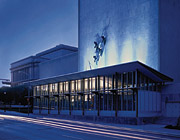
Located within this new space at the Public Museum is the remarkable Butterfly Vivarium exhibit. It is rated as one of the two best butterfly exhibits in North America and has been constructed as an open walk-through experience that allows visitors to interact with the butterflies as they pass through the 75-ft-long simulated tropical rain forest environment. In this enclosure a wide variety of butterfly species, indigenous to the Central and South American jungles, fly freely amongst their guests although they are not permitted to leave with them.
A Monumental Challenge
In order for the butterflies to continue to thrive in Milwaukee, where seasonal temperatures that range from about 100° to -20° F, the architects and environmental engineers had to devise a system that could ignore whatever was going on outside. This created a monumental challenge for Kevin Pope and his team at HGA Inc., who were responsible for the design of this living showcase.The not only had to maintain the air temperature at a steady 80°, night and day, they also had to keep the humidity level throughout the entire area at a constant 80%, even as exterior conditions impacted on the humidity in the air being pumped into the building from outside. And the air inside the exhibit had to be recirculated completely every 15 to 20 minutes without creating any discernible breeze. The butterflies only live in their flying state for a few weeks, and they require optimum living conditions to thrive and procreate their species. They don't like it to be too cold or too hot, or too moist or too dry; they want it to be just right.
And then there was also the FDA, which has strict regulations pertaining to plants and creatures that are indigenous to exotic regions and have been brought into the United States. They must be confined securely in areas where they cannot contaminate American livestock or vegetation. The butterflies had to stay in their artificial rain forest and not be able to get out.
Pope and his team, under the supervision of Richard Swainston, the museum's facility engineer, were able to come up with a design that satisfied all these environmental and regulatory challenges. It also enabled the museum to use the vivarium as a showcase window into the museum for passers-by outside on busy Wells Street, in the middle of downtown.
An 80° Envelope
Essentially the structure is a sealed, three-sided, double-glass walled and roofed rectangle with interior dimensions about 75 ft long and 20 ft deep. There is a space between the inner and outer glass walls of about 2 ft that contain automatic, electronically controlled mechanical shades that respond to changes in solar intensity. This space is maintained with forced air at a temperature of 80°, creating an insulating blanket against changes in the exterior environment, no matter whether it gets too hot or too cold outside. This effectively isolates the interior from all exterior climatic influences and eliminates both icing and condensation on exterior and interior glass surfaces.With the interior effectively cocooned, attention was now focused on the heating, air conditioning, and humidification systems that would control and maintain the interior air at the appropriate levels. This equipment would have to be thoroughly reliable and sensitive to every subtle change in demand, delivering humidity accurately and efficiently year-round.
Pope worked closely with sales engineers from Vyron Corporation, Nortec's Milwaukee agent, in choosing an AirFog AFE atomizing humidification system supplying and controlling 16 strategically placed nozzles. Each nozzle is individually set to maintain fogging patterns that provide even humidity throughout the entire enclosure. Machined from 316-gauge stainless steel, the nozzles have self-cleaning pins to minimize maintenance. The timer for the cleaning pin is adjustable to match the quality of the water supply. The mist from the AirFog nozzles also creates the ambience of a rain forest for museum visitors.
The butterflies are prevented from leaving the area by maintaining a negative interior air pressure that blows them back from each entry and exit door if they are too close when the doors are opened. Also a fine mesh filter is fitted over all the air supply and exhaust fittings. The vivarium has been up and running reliably now for over a year, which proves that careful planning and good design and craftsmanship can overcome seemingly impossible odds.ES
